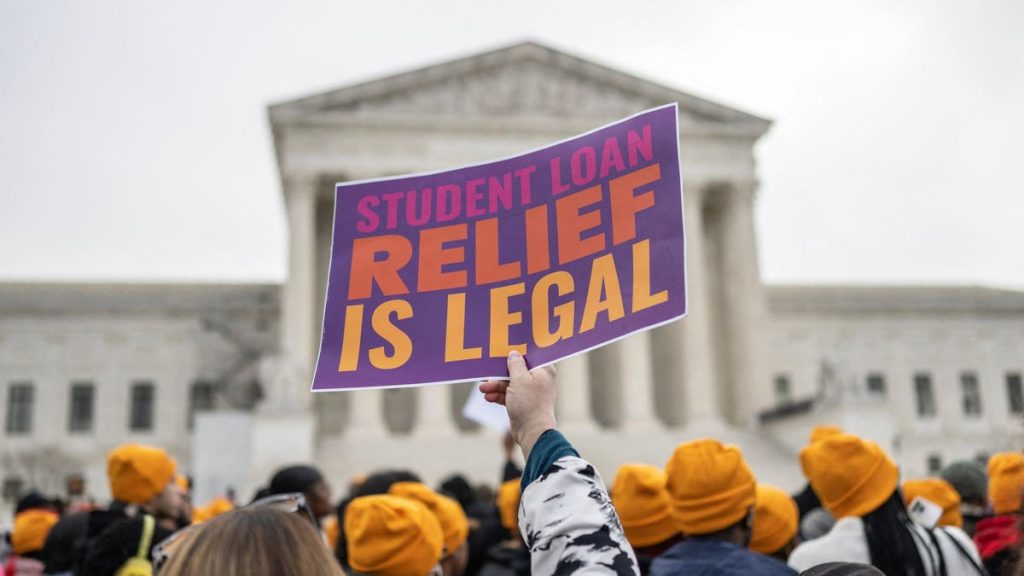Topline
Millions of federal student loan borrowers will not receive up to $20,000 in debt relief as the Biden Administration had intended, as the Supreme Court Friday ruled against the White House in one case challenging the policy, ending months of uncertainty over the program’s fate and delivering a win to Republicans who argued the administration was overstepping its authority.
Key Facts
The Supreme Court heard arguments in two cases challenging the Biden loan forgiveness program, one brought by six GOP-led states and another brought by two individual borrowers, backed by the conservative Job Creators Network, who didn’t qualify for the full amount of student loan forgiveness.
The lawsuits argued the Biden Administration overstepped its authority through the loan forgiveness program, which would forgive $10,000 in federal student debt for borrowers earning less than $125,000, or $20,000 in forgiveness for Pell Grant recipients.
The Biden Administration argued it did have authority to implement the loan forgiveness under the HEROES Act, which allows the Secretary of Education to “waive or modify” student financial assistance programs during national emergencies, and claimed the challengers don’t have standing to bring the lawsuits in the first place and they should be thrown out.
The court ruled unanimously in favor of the Biden Administration in the borrowers’ lawsuit, finding they lacked standing to bring the case, but sided 6-3 with the GOP states—with the court’s three liberal justices dissenting—meaning the policy has been struck down.
At least Missouri has standing to challenge the student loan policy, the court ruled, because its government corporation that handles student loans would be affected by the policy, and the court found the HEROES Act “does not allow the Secretary [of Education]
” to cancel “$430 billion of student loan principal.”
The HEROES Act’s allowance for student financial assistance to be “waive[d] or modif[ied]” only means the Education Department can “make modest adjustments and additions to existing provisions, not transform them,” Chief Justice John Roberts ruled for the court, arguing it’s “highly unlikely” Congress intended for the law to allow something as sweeping as student loan forgiveness.
Crucial Quote
“The Secretary asserts that the HEROES Act grants him the authority to cancel $430 billion of student loan principal. It does not,” Roberts wrote. “We hold today that the Act allows the Secretary to ‘waive or modify’ existing statutory or regulatory provisions applicable to financial assistance programs under the Education Act, not to rewrite that statute from the ground up.”
Chief Critic
“In every respect, the Court today exceeds its proper, limited role in our Nation’s governance,” Justice Elena Kagan wrote in her dissent for the court, joined by Justices Sonia Sotomayor and Ketanji Brown Jackson, adding that in its ruling, “the Court substitutes itself for Congress and the Executive Branch in making national policy about student-loan forgiveness.” “Congress authorized the forgiveness plan (among many other actions); the Secretary put it in place; and the President would have been accountable for its success or failure. But this Court today decides that some 40 million Americans will not receive the benefits the plan provides, because (so says the Court) that assistance is too ‘significan[t].’”
What To Watch For
The court’s ruling means that the Biden Administration’s student loan forgiveness plan will not move forward in its current form, and no money will be paid out to borrowers who applied for debt relief before the program was suspended. The Biden Administration has yet to comment on if it will try to retool the program using a different legal justification, though that would likely still face more challenges in court. President Joe Biden is expected to announce new measures in response to the court’s ruling as soon as Friday, according to the Messenger. The Department of Education has said borrowers will need to start making payments on federal student debt in October and interest will start accruing again September 1, after a deal reached between the White House and Congress on raising the debt ceiling formally abolished the ongoing payment pause.
Big Number
26 million. That’s how many people applied for student debt forgiveness before the program was suspended in November, according to the Education Department, which is more than half of the 43 million borrowers eligible. Of those applications, 16 million borrowers have been approved so far to have their debt forgiven, but no funds were disbursed before the program was halted.
Key Background
The Biden Administration announced its student loan forgiveness program in August following heavy pressure from Democrats, immediately sparking Republicans’ ire and prompting a wave of litigation. The two successful cases that ended up before the Supreme Court both resulted in lower court judges blocking funds from being disbursed, and the Biden Administration paused the program in November in response. Since the Supreme Court took up the case, Congress passed legislation that would repeal the student debt relief program, but Biden vetoed the bill and House lawmakers were unable to secure the votes needed in order to override it.
Surprising Fact
The White House justified student loan relief through the Covid-19 pandemic, arguing that it was a national emergency that gave the administration the authority to cancel debt under the HEROES Act. Though the White House formally ended the national emergency for the Covid pandemic in May, the administration has argued student debt relief is still justified because of the pandemic and it’s separate from the end of the national emergency. “There was a national emergency that impacted millions of student borrowers,” an administration official told Insider. “Many of those borrowers still face risk of default on their student loans due to that emergency.”
Tangent
In addition to the more sweeping debt relief plan, the Biden Administration has also imposed a number of other measures regarding student loans that are separate from the Supreme Court cases and aren’t impacted by its decision. The administration has announced changes to debt repayment plans that are based on a percentage of borrowers’ discretionary income, which are designed to reduce borrowers’ monthly payments, and has also expanded debt relief for public servants.
Student Debt Forgiveness At Supreme Court Tuesday—Here’s What You Need To Know (Forbes)
Supreme Court’s Conservative Majority Wary Of Biden’s Student Loan Forgiveness Plan (Forbes)
Biden ‘Not Confident’ Supreme Court Will Uphold Student Debt Cancellation (Forbes)
Read the full article here










